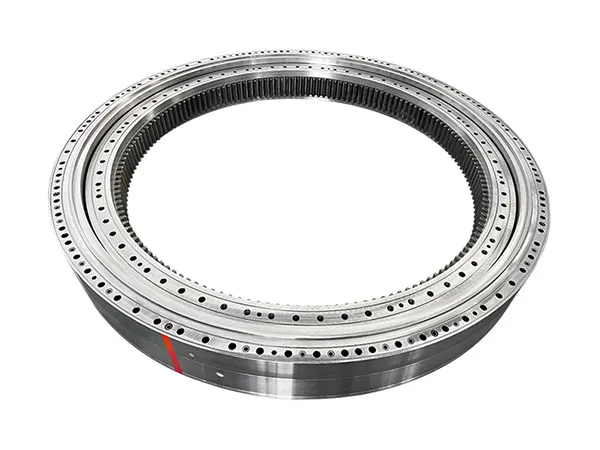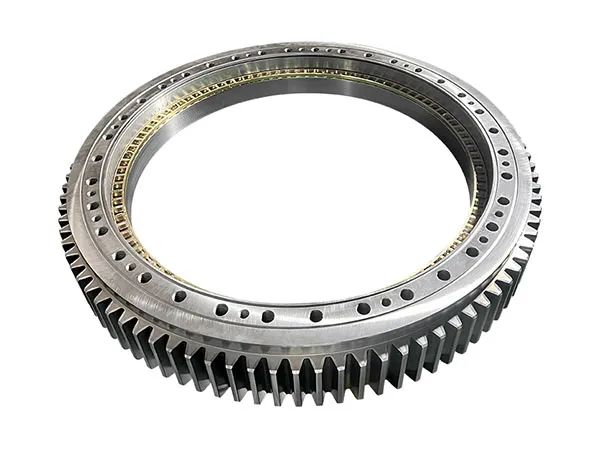- +86 13837949030 +86 15890619536
- info@lymcbearings.com export@lymcbearings.com
- Luoxin Industrial Cluster, Luoyang City,Henan Province,China
Time:2025-10-27 07:02:10 Source:LYMC Slewing Bearing
In modern heavy machinery and precision systems, slewing bearings are indispensable components that enable smooth rotation, tilting, and oscillation. They serve as the“joint" of mechanical equipment, ensuring structural stability and precise motion.
Understanding the differences between single-row and double-row slewing bearings-and how their specifications affect performance is crucial for mechanical engineers, designers, and purchasing managers. The right bearing choice can significantly enhance efficiency, reliability, and lifespan while reducing maintenance costs.
A slewing bearing (also known as a turntable bearing or slewing ring) is a specialized bearing designed to carry axial, radial, and overturning moment loads simultaneously. It typically consists of:
Inner and outer rings
Rolling elements (balls or rollers)
Spacer and sealing components
Its structural advantage allows heavy-duty equipment to rotate smoothly under substantial load without excessive friction.
Common applications include:
Construction and mining machinery
Cranes and aerial platforms
Wind turbines and solar tracking systems
Industrial robots and automation lines
Port lifting equipment and radar systems
1.Four-Point Contact Ball Slewing Bearing
The single-row four-point contact ball bearing is the most widely used type. Each steel ball makes contact at four points, enabling it to carry combined axial, radial, and moment loads simultaneously.
It features a simple structure, easy installation, and cost-effective performance, making it suitable for medium-load applications.
Typical Uses:
Excavators, cranes, welding positioners, small wind turbines, and industrial automation systems.
Key Specifications:
Diameter Range:400 mm to over 3000 mm
Load Capacity: Determined by ball diameter and raceway hardness
Rotational Accuracy:Standard precision, ideal for moderate-speed rotation
Mounting Options: Internal gear, external gear, or gearless configurations
Material: High-strength alloy steel with heat treatment for wear resistance
2. Cross Roller Slewing Bearing
The single-row cross roller slewing bearing uses cylindrical rollers arranged at a 90°angle. This configuration allows it to handle high axial, radial, and moment loads with superior rigidity and precision.
Because of its stiffness and high positioning accuracy, it's ideal for robotic joints,CNC turntables, and radar antennas.
Advantages:
High torsional rigidity
Compact design with minimal deflection
Excellent rotational precision

1. Double-Row Different Diameter Ball Slewing Bearing
This design uses two rows of steel balls with varying diameters, distributing loads more evenly and providing higher load capacity and better resistance to overturning moments.
It’s perfect for applications involving large loads and high stability demands, such as heavy cranes, tunnel boring machines, and large excavators.
Key Features:
Enhanced load distribution between inner and outer rows
Excellent anti-tilting capability
Longer operational life under heavy loads
Requires efficient lubrication systems for reliability
2. Double-Row Roller Slewing Bearing
This is the most robust type of slewing bearing. It combines the strength of a double-row design with the superior contact surface of rollers.
Applications:
Port cranes, shield tunneling machines, large ship decks, and wind power equipment.
Benefits:
Exceptional load-bearing capacity
High stiffness and shock resistance
Reliable under extreme and unbalanced loads
Selecting the ideal slewing bearing involves balancing performance, cost, and environmental conditions.
Key Factors to Consider:
1. Load Conditions:
Assess axial, radial, and tilting loads during operation to determine appropriate bearing typel and size.
2. Operating Environment:
Consider temperature, humidity, dust, and corrosion. Sealing and material selection should align with these conditions.
3. Speed and Accuracy:
High-precision applications (e.g., robotics) require cross roller types, while moderate precision machinery may use four-point contact designs.
4. Service Life & Maintenance:
Choose bearings with suitable lubrication systems and sealing protection to minimize downtime.
5. Space and Weight Constraints:
Compact designs are preferred in equipment with limited installation space.
6. Budget and Cost Efficiency:
Balance between cost, load requirements, and operational efficiency.

|
Industry |
Typical Application |
Bearing Type |
|
Construction Machinery |
Excavators, cranes |
Single-row four-point contact |
|
Wind Power |
Yaw and pitch systems |
Double-row roller |
|
Robotics |
Robotic arms, turntables |
Single-row cross roller |
|
Port Machinery |
Container cranes, loaders |
Double-row roller |
|
Medical Devices |
CT scanners, surgical tables |
Single-row compact type |
1. What is the difference between single-row and double-row slewing bearings?
Single-row bearings are lighter, simpler, and more cost-effective, suitable for medium-load applications.
Double-row bearings offer higher load capacity and rigidity, making them ideal for heavy-duty operations.
2. How long do slewing bearings last?
Service life depends on load, lubrication, and operating environment. With proper maintenance, quality slewing bearings can last from 5 to 20 years.
3. Can slewing bearings be customized?
Yes. Manufacturers can customize diameter, gear type, material, and sealing options to fit specific applications.
4. How often should slewing bearings be lubricated?
For heavy-duty applications, lubrication is typically recommended every 100-500 hours of operation, depending on load and speed.
5. What materials are commonly used?
Most slewing bearings are made from42CrMo or 50Mn alloy steel, known for high strength, toughness, and wear resistance.
Whether it's a compact single-row slewing bearing for moderate-duty machinery or a double-row bearing for extreme heavy loads, understanding their specifications and performance characteristics is essential.
By carefully evaluating your application’s requirements, you can choose the optimal bearing that enhances efficiency, stability, and longevity, ensuring reliable performance across diverse industrial environments.